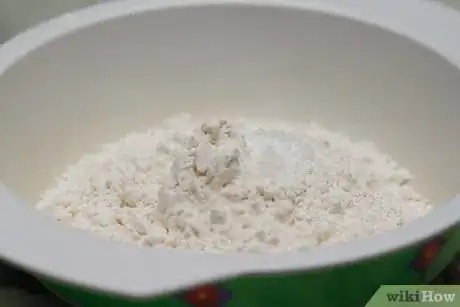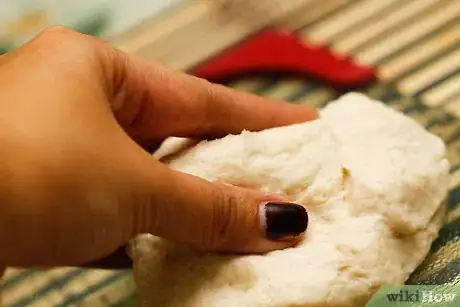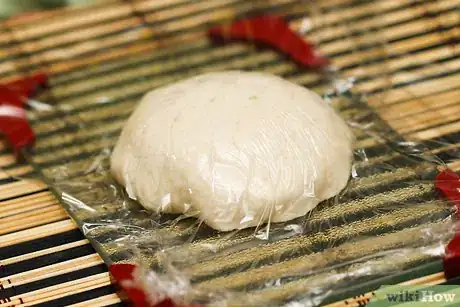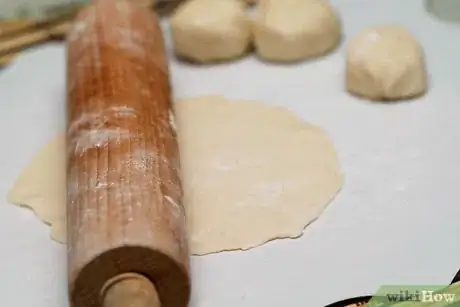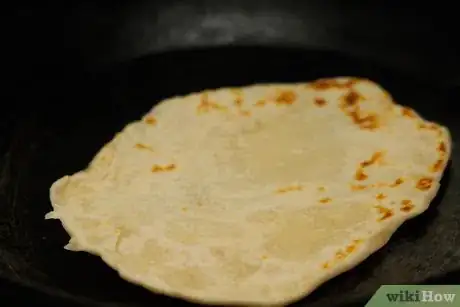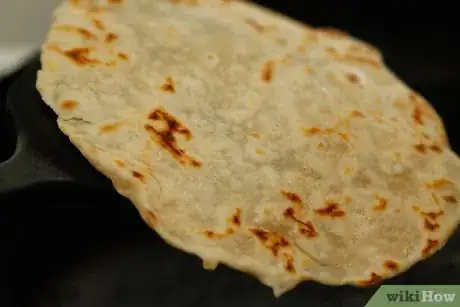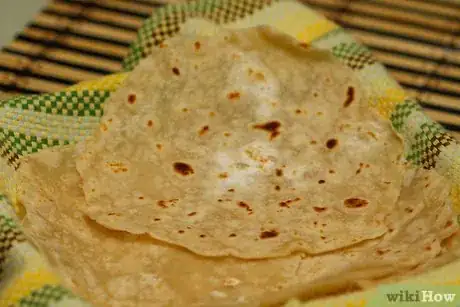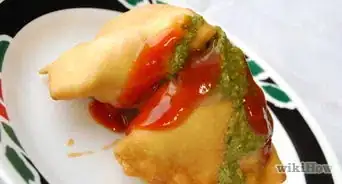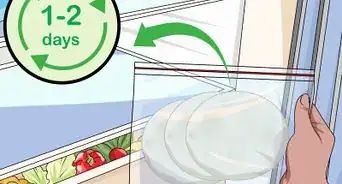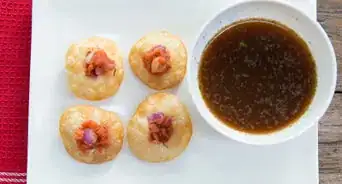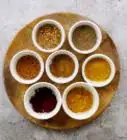This article was co-authored by wikiHow Staff. Our trained team of editors and researchers validate articles for accuracy and comprehensiveness. wikiHow's Content Management Team carefully monitors the work from our editorial staff to ensure that each article is backed by trusted research and meets our high quality standards.
wikiHow marks an article as reader-approved once it receives enough positive feedback. This article received 24 testimonials and 83% of readers who voted found it helpful, earning it our reader-approved status.
This article has been viewed 1,144,284 times.
Learn more...
Similar to the common pita, the Indian chapati is a bread made of whole wheat flour. It is usually served with a curry, but it is very versatile: it can be used just like regular toast, or as a side to many dishes. The meal is used by many, especially in Africa, as a primary source of starch besides maize and potato family.[1]
- Prep time: 50-60 minutes
- Cook time: 10 minutes
- Total time: 60-70 minutes
Ingredients
- 2 cups of wheat flour or durum wheat atta
- 1 cup lukewarm water
- 1 tsp. salt (optional)
- 1-2 tsp. ghee (optional)
- Makes 10-12 chapatis
Steps
-
1Pour the wheat flour, salt, and ghee into a bowl and mix the ingredients together. If you can get some durum wheat atta, this will give you the tastiest results. Though wheat flour is perfectly fine to use, it can lead the final product to be slightly more chewy, and will make it dry out a bit faster. In any event, place 2 cups of wheat flour or atta, 1 teaspoon of salt, about 1/2 teaspoon of ghee into a bowl and use your hands to mix the ingredients together thoroughly. Your hands will work better than any mixing tools for this one. You may even sift the flour and salt together before adding the ghee.[2]
- If you really want to be health-conscious, you can skip the ghee, but the chapatis won't be as tasty. If you can't find any ghee, you can substitute olive oil. It won't be quite as authentic, but it should do the trick.
- Though these are the only ingredients you need to make a traditional chapati, you can add a teaspoon or so of your favorite spice, such as chili powder, if you want to make an addition to this simple recipe.
-
2Add ½ a cup of water to the flour mixture and stir the mixture until it's soft and supple. Most people recommend lukewarm water, but you can even use water that is a little warm, which will make it easier to knead the dough. For best results, mix the flour with your fingers in a circular motion as you add a little bit of water at a time. Dumping in all of the water at once will make it a bit harder to stir the ingredients. At first, the mixture will feel pretty coarse, but as you add more water, it'll start to stick together.[3]Advertisement
-
3Add the remaining water slowly, stirring until it's fully combined. Continue to add the water until you've added all of it and the dough seems to really come together. Once you feel like you've mixed it together pretty thoroughly, you can knead the dough with your knuckles until it's soft and round. Knead the dough for about 10 minutes. It's important to knead the dough as well as you can so that the gluten is formed. When fully kneaded, the dough should be nice and smooth; if it's too hard, then the chapati won't puff up. However, if it's too soft, then it'll be harder to roll it and it won't puff up, either. It's important to find the perfect balance.[4]
-
4Place the dough into an oiled bowl and cover it for 25 minutes. Cover the bowl with a cloth; use cling wrap only as a last resort. This should give the dough enough time to come together. If you let it sit for much longer than that, then the dough will lose some of its moisture. Some people say you should let it sit for 30 minutes or more, however. Start with the lower time and do it for longer the next time you make chapati to find what works best for you.[5]
- Optionally, when this time has passed, you can moisten your hands with a bit of oil or ghee and knead the dough for another five minutes. It should feel both smooth and supple when you're done.
-
5Divide the dough into 10-12 small balls, and dip them into flour. Each ball's diameter should be around 3 inches (7.5 centimeters), but you don't have to make them all equally sized. You should use your hand or a rolling pin to lightly flatten each ball and then drench it with flour on both sides. For best results, keep the rest of the balls covered with the cloth while you flatten each one and cover it with flour. If you uncover all of them, you will release more of their moisture.[6]
-
6Roll the dough with a rolling pin until the balls resemble thin, round pancakes. The first time around, don't expect these balls to come out perfectly round. That's okay -- they'll still taste delicious, and you'll get the hand of it as you perfect your skills. Rolling the dough until it is even will make it possible for the entire chapati to puff up.
-
7Heat a heavy frying pan, tawa, or griddle over medium heat and cook each chapati on both sides. Place the chapati on the pan, cook it until it's a bit less than halfway cooked, and then flip it over and raise the heat a bit. Once you flip it over, the chapati will begin to fill with air. You should keep cooking it until blisters appear on both sides of the bread's surface. You should rotate each chapati every few seconds to make sure that it gets cooked evenly.
- As you see the chapati filling up with air, you can lightly press down on these spots to encourage the air to pass through the entire chapati. This puffiness will make the chapati nice and soft. Once the chapati has fully puffed up, you can take it off the stove.
- Some people will say that, once you start cooking the second side of the chapati, you should cook it directly over the fire of your stove, using tongs to flip it over. If you do this, make sure your stove is very sterilized and that you take extreme care.
-
8Remove the chapati from the heat, and wrap it in a towel until they are all ready to serve. You can also place it in a container that is lined with a towel. Make sure to cover each chapati as soon as it's cooked for best results.
-
9Serve. Enjoy this delicious chapati with curry or pickles or use it as a wrap. You can even brush the chapati with some ghee to add an extra burst of flavor. You can easily enjoy these staples of Indian cuisine on their own.
Community Q&A
-
QuestionMay I use hot water for mixing?
 Community AnswerUse warm water. This makes the dough softer and easy to roll out.
Community AnswerUse warm water. This makes the dough softer and easy to roll out. -
QuestionCan chapati be made without olive oil or ghee?
 Community AnswerYes, chapathi can be made without olive oil or ghee, as is your preference.
Community AnswerYes, chapathi can be made without olive oil or ghee, as is your preference. -
QuestionCan I add baking powder?
 Community AnswerNo, baking powder will not work and will make the chapati dry. For best results, use flour and water.
Community AnswerNo, baking powder will not work and will make the chapati dry. For best results, use flour and water.
References
- ↑ https://www.desiblitz.com/content/history-of-chapati
- ↑ http://www.journeykitchen.com/2014/01/how-to-make-everyday-indian-flatbread.html
- ↑ http://www.tarladalal.com/Chapatis-7608r
- ↑ http://www.vegrecipesofindia.com/rotis-made-from-whole-wheat-flour/
- ↑ https://www.allrecipes.com/recipe/85469/indian-chapati-bread/
- ↑ https://www.bbc.com/food/recipes/chapatis_77146
About This Article
To make chapati bread, first add 1 cup (130 g) each of whole wheat flour and all-purpose flour to a large bowl. Then, add 1 teaspoon (6 g) of salt, and stir everything together. Next, stir in 2 tablespoons (30 mL) of olive oil and around ¾ cup (175 mL) of hot water. Gradually add the water until the dough is elastic, but not sticky. Knead the dough until it’s smooth, then divide it into 10 pieces, or more or less depending on how big you want your chapati bread to be. Shape each piece into a ball, and let them rest for 10 minutes. After 10 minutes, roll out each ball on a floured work surface until the dough is thin, like a tortilla. Heat a skillet over medium heat until it’s hot, then place one of the chapatis on it. Cook the chapati for 30 seconds, or until it starts to brown on the bottom. Then, flip it over and cook for 30 more seconds. Repeat with the rest of the chapati, and serve warm. If you want to learn more, like what to serve your chapati bread with, keep reading the article!
